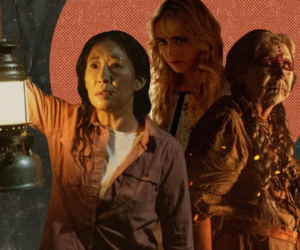Halloween night just passed, so who would expect a post about horror films the very next day? Everyone? Oh, then we will proceed without the surprise element in hand. With Halloween coming and going, I was thinking a bit about the horror genre, and how most of the mainstream installments rely on overused tropes and cheap scares. So, as a result, I compiled a list of tips for breaking stereotypes and delivering quality content. It’s quite likely a very subjective listing, so please do take it with a grain of salt.
1. Build tension, don’t rely on jump scares THAT much
When I’m watching a horror flick, the thing that terrifies me the most is not the actual scare, but the buildup that might (or even better, might not) lead to a sudden jump. This is because the buildup is a constant accumulation of tension, one that keeps you frightened and on edge – and a jump scare is nothing else than the release of said tension. Yes, the surprise element might startle you for a split of a second, but it also brings along relief – the tension is gone, you’re now aware of the monster (and thus possess more information and less uncertainty) and can come up with responses based on the stimulus. However, during the tension accumulation stage, you have little to work on, cannot muster a response, and you’re left in a helpless anticipatory state, a feeling that to me, is much superior to that cheap half second jump.
Great example: The Witch. This masterpiece used exactly one jump scare, and not even that was the traditional cheap kind, but more of a refined relative. The nerve-wracking tension keeps adding up and is rarely released – and this is exactly what gives the film its creepy vibe.
2. Don’t show the monster
Remember my previous point about having information to work on and respond to? Well, if you don’t see the monster, then you don’t know what to expect. And, as long as the atmosphere is creepy enough and a threat is perceived, you don’t need much more. If there are no visual cues to take into consideration, the limitless potential of the human imagination takes over, since your worst fears are not disproved, and thus you can create your own interpretation of the monster. Somewhat reminiscent of H.P. Lovecraft’s take when describing a monster that is too horrible for the human mind to comprehend.
Great example: The Blair Witch Project. Do you, at any point during the film, see the Blair Witch, or any other supernatural being? Nope – you’ve only got indirect signs that point towards such entities, you’ve got Heather’s cue when she shouts out ‘What the fuck is that?’ while running away, but you don’t actually see anything. It could be anything, and it is.
3. Always show the monster
Now, you could do the entirely opposite thing, and show the monster on a constant basis. This can work to great effect, but you need to keep in mind a few design choices in order for this to work out. First, you have to build the impression of helplessness despite being able to see the monster – seeing it does not diminish the threat. Then, the monster has to feel out of place in all its visual contexts – this is exactly what creates the aformentioned sense of creepiness. Objects, people or things that are not in places you’d expect them to be ooze a creeping unease.
Great example: It Follows. For one, Jay can see the approaching monster at all times – she mostly finds herself in open environments, and the entity moves at an extremely slow pace, so there’s rarely an element of surprise based on sudden movements. Why this is so effective is because it creates a sense of helplessness and unavoidability – and the threat becomes even more poignant when the monster is not seen. Secondly, the monster always takes human form, but its apparel and out of place-ness is what makes it terrifying – an old woman in pajamas slowly walking on a high school corridor, or a naked man staring blankly from the roof of a house.
4. Play with sound without overdoing it
Sound is a vital companion for visual cues in delivering a top-notch horror experience. Sure, it can be done without, but it’s extremely difficult to do so. One tip could be giving the monster a soundtrack, or hinting towards its presence with a recurrent audio element, such as a screech, static or hum. Through the process of conditioning, the viewer will hear the cue and immediately be flooded with unease, since he or she understands the implications of such a sound. This should be used in moderation, however – if there is no consistency, and you bombard the audience with cues, their meanings will be lost, and the impact will subsequently be much lower.
Great example: The Shining. The Overlook Hotel is personified as a supernatural entity in its own right partly through the use of sound – and thus, such cues convey a lot of information about the environment, how characters are situated within the environment and in relation to it, as well as setting up the mood. And, at times, the lack of sound can be more haunting than the presence of sound: Jack is locked in the basement, and keeps banging on the door. Wendy is rightfully creeped out by this, but the repetitive sound makes her able to pinpoint Jack’s coordinates, and feel safe. However, when the banging suddenly stops, uncertainty seeps in – why has it stopped, and what does this mean?
















